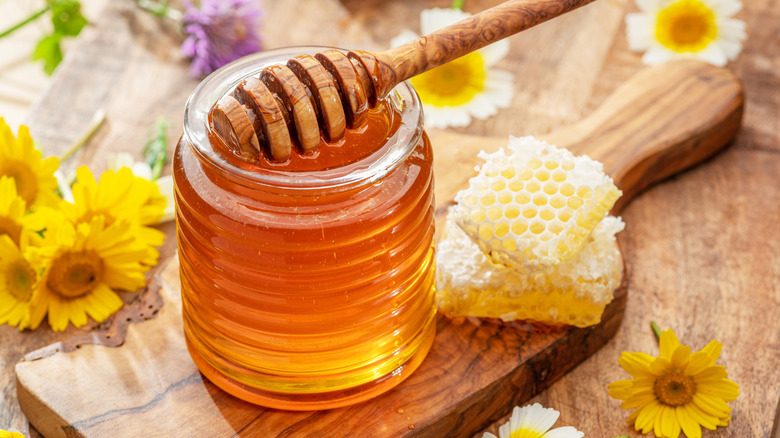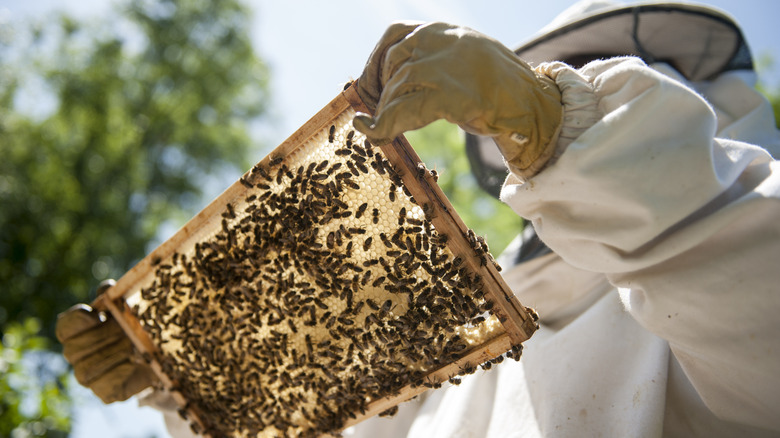How Many Bees Does It Take To Make A Jar Of Honey?
We may receive a commission on purchases made from links.
With anywhere from around 20,000 to 80,000 residents, depending on the season, honey bee colonies are busy places. One queen bee commands a hive of male drone bees and sterile female worker bees who go on missions to gather nectar and water, build and repair the hive, tend to the queen and her eggs, and repopulate the colony. They communicate with each other through pheromones and dancing, wiggling to send messages to the other bees, and together, they make honey, which they eat and store in the walls of the hive for later. Of course, many of us eat and store the sweet substance in our homes, too, but we may not consider just how many bees work to make a single jar's worth.
A healthy colony in good conditions with access to plenty of food can produce up to 100 pounds of honey per year. But that's if the colony is large and the bees are healthy. And even in those perfect conditions, the work never stops for the bees. How much nectar a working bee brings home depends on its species and the season, but in general in one trip, a healthy worker bee can bring home about 70 milligrams of nectar, visiting around 1,500 flowers. That means in its entire lifespan — which can be as short as a few weeks or up to about 6 months depending on the season and their role in the colony — the average bee will only bring home enough nectar to make about one-twelfth of a teaspoon of honey. Put another way: It takes 12 bees to produce just 1 teaspoon of honey, so a full tablespoon for your next batch of honey soy marinated chicken thighs or your homemade version of Starbucks' Medicine Ball requires the life's work of 36 honeybees. That means filling a 16-ounce jar with honey takes 1,152 bees.
How do bees work together to make so much honey?
A flurry of action begins as soon as a worker bee leaves the hive in search of nectar. First, that honeybee collects nectar and stores it in her second stomach, which is specially dedicated to the task, as she flies back to the hive. Then, the bees pass the nectar back and forth to each other, adding enzymes from their bodies to it. Eventually, they store the the honey in honeycomb — the hexagonal beeswax cells — to dry, flapping their wings over it to speed up the process. Once sufficiently dried, the honeycombs is then harvested by beekeepers to be turned into products by companies like the supplier for Costco's Kirkland brand honey or bottled by small operations for local production.
While the worker bees are busy building a honey fortress for the colony and tending to the queen, drone bees are on standby for repopulation. During the mating season, male honeybees gather in a swarm outside of the beehive. Eventually the queen will follow, flying nearby, drawing male bees from the swarm, and mating with 10-20 drone bees mid-flight, creating the next generation of honey-retrievers. While there are many factors that could cause the death or decline of a colony, hives can continue indefinitely. So while the bees that made your 16-ounce jar of store-bought honey aren't around anymore, the colony where the honey came from could very well still be thriving.
How honey is harvested and treated
Perhaps the details about honey harvesting and processing aren't the first thing to come to mind when you're making a jar of homemade hot honey or adding a little sweetness to your morning coffee before work. But it's worth noting that beekeepers who practice sustainable harvesting make sure to leave enough honey for the colony to survive. With that, extracting honey from the hive doesn't impact the bees, though some beekeepers infuse the hive with wood smoke before gathering any honey — a process that prevents the bees from ringing alarm bells (producing a particular pheromone) and panicking about intruders.
Once the honey is extracted from the hive, there are several processing styles that can impact its quality and flavor. Regular, standard honey is strained so all parts of the honeycomb are removed and heated for preservation. Raw honey products like Y.S. Organic Bee Farm's raw honey are not heated after filtering. You'll also find honey that comes with pieces of honeycomb, such as Nate's 100% Pure Raw & Unfiltered Honey. While you'll likely only see a handful of popular honey types on the shelves of your average grocery store, there are more than 300 types of unique honey produced in the United States alone, according to the National Honey Board — all made from nectar sourced from fields close to the hives of honeybees.


